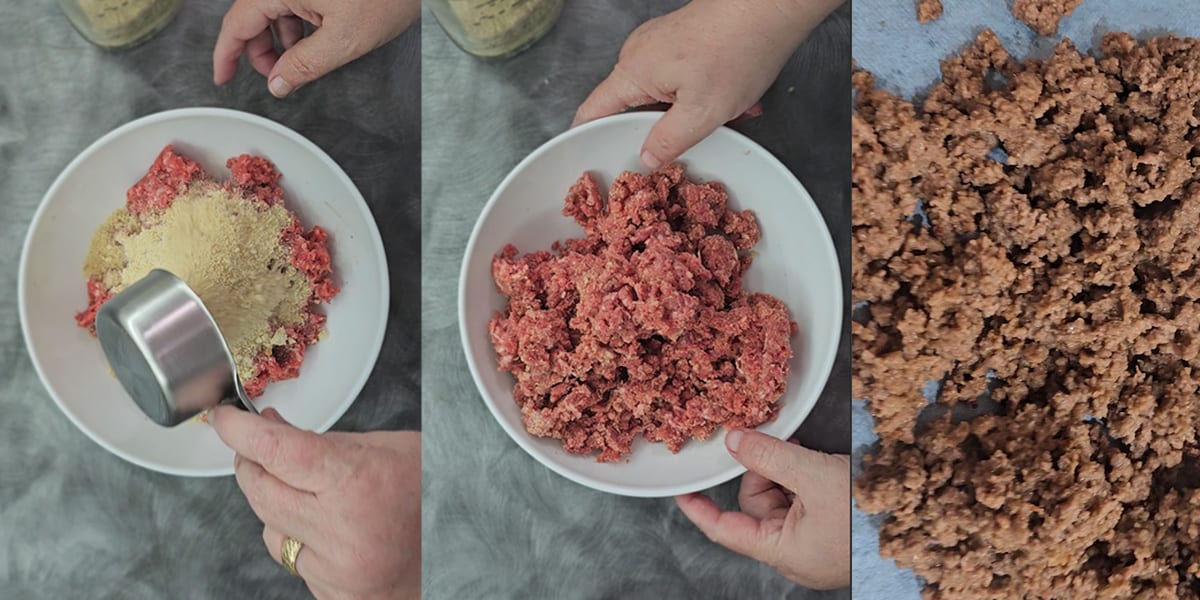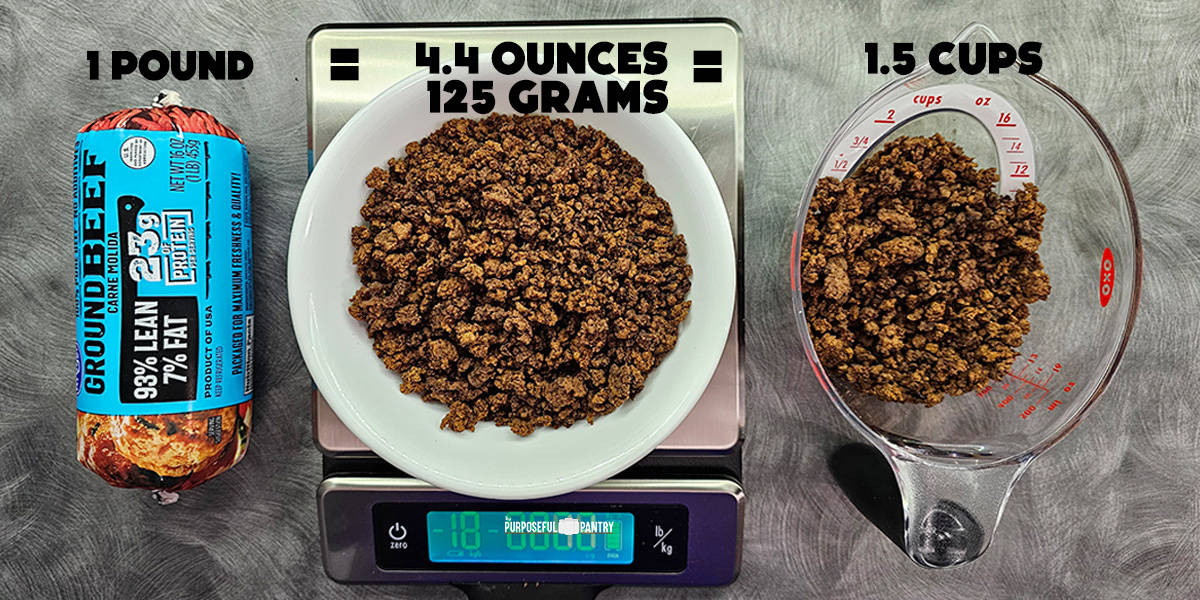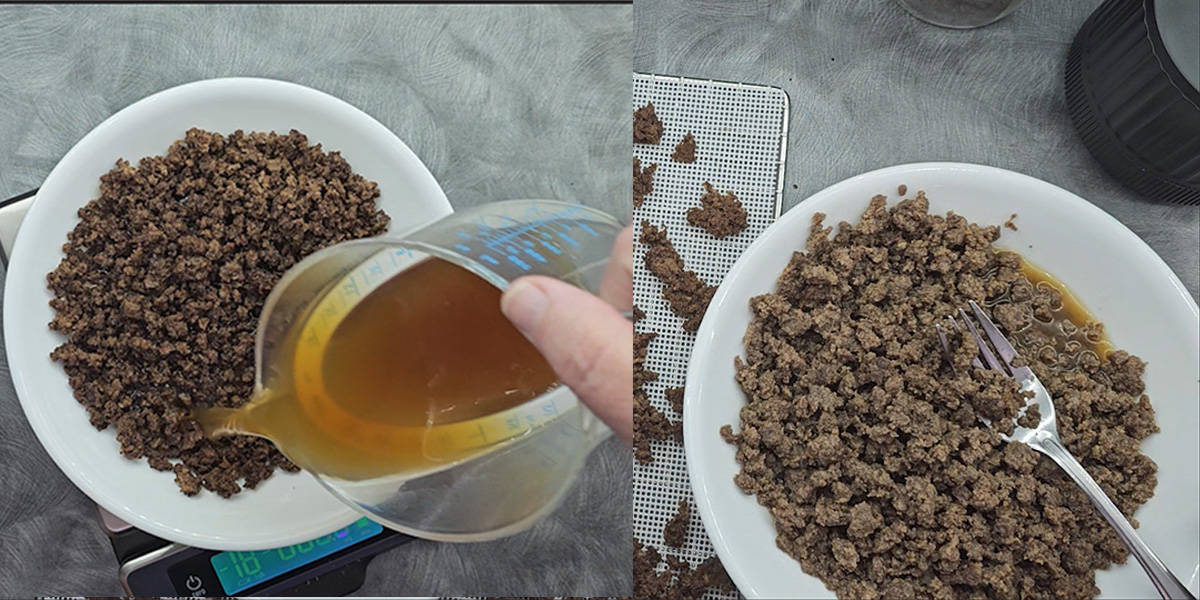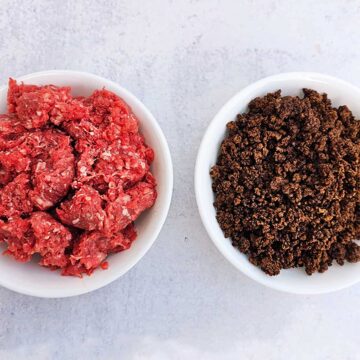Is it Safe to Dehydrate Raw Hamburger Meat?
Yes, it is completely safe to dehydrate ground beef, and if you follow the instructions below, you’ll have deliciously dry, dried ground beef that you can use in a variety of ways.
The secret is using the right temperatures to kill bacteria and removing as much fat from the meat as you can to prevent it from going bad on the shelf.
How to Dehydrate Ground Beef
Don’t add extra fats to the cooking process if you’re browning extra ground beef for dinner tonight to help lower the amount of fat in the finished product.
You can make shelf-stable pantry storage with the aid of these hamburger rocks or nuggets to use for:
- Backpacking meals
- meals in a jar to have on hand for quick weeknight dinners or to give to friends and family who could use a helping hand.
- assurance that you have food in the pantry when you need it, even if prices go up or your budget is tight that week.
Use lean ground beef. The less fat the better even though I use 93/7 lean ground beef.
Pick the leanest beef you can find, or have your butcher grind some ground sirloin, ground round, or ground chuck. If you have your own Kitchen Aid grinding attachment or another manual meat grinder, you can grind your own.
Note: You can use ground turkey, chicken, or even sausage for this. For best results, you’ll need to be more careful about carefully trimming the fat from the sausage before freezing it.
- Skillet or frying pan
- I really like these wooden spurtles for stirring because they make me think of my grandmother’s wooden utensils.
- Food Dehydrator
- Mesh silicone sheets or parchment paper
- Colander
- Bowl
- Newspaper or paper towels (for this application, we like to use Scott blue shop towels)

- In your preferred skillet or frying pan, cook extra lean ground beef until well-done over medium-high heat. If you’d like, you can season the meat with garlic powder, onion powder, salt, and pepper. I find it makes a better result.
- Drain beef in a colander over a bowl or stockpot. This aids in removing any remaining moisture and fat from the beef.
- To remove extra fat, place the beef onto paper towels, old tea towels, or newspapers (most newspapers now use non-petroleum inks). I roll in the paper towels to wring out as much fat and moisture as I can.
- Use a scale to weigh meat to determine how much a serving or pound of beef will weigh after being cooked.
- Place the meat onto dehydrator trays. To contain the tiny pieces of meat, I’ve discovered that using a fine-mesh sheet like these from Kispog works best.
- Dry at 145°F/60°C or above for 4-10 hours. Increasing the temperature will make this process go a little faster because you aren’t trying to preserve nutrients at this point.
- If necessary, pat the beef while it is being dried to remove any released extra fat.
- Test for dryness (crumble easily with no obvious moisture). These will be like little hamburger pellets or crumbles.
- To determine the weight after drying the ground beef portion from step 4, reweigh it. What you’ll want to use to rehydrate the dried ground beef differs. To have this information available when rehydrating, make a note of it in your dehydration journal.
Consider boiling more ground beef instead of browning it in a skillet. It enables you to accomplish more, lowers the fat content, and produces fantastic beef broth that can be consumed later.
Backpacker’s Secret to Dehydrating Ground Beef
While Ive always just dehydrated ground beef, the Backpacking Chef has a great trick for making ground beef a little less pebbly in texture and rehydrates a little faster.
He is a great resource for dehydrating trail food, so I had to try his method!

- For every pound of raw ground beef, add a half cup of dried bread crumbs.
- Mix gently until well combined, but not longer. You dont want to overwork the beef.
- Cook as normal and follow dehydrating instructions above.
This not only alters the texture to resemble meatloaf somewhat, but also speeds up the process of rehydrating!
When I used it, I didn’t notice the taste or final texture as much, but it did rehydrate more quickly. Therefore, I won’t do this step when using it at home, but if I were hiking or camping, I would definitely do it to speed up rehydration.
You can watch the video I did testing his method with mine on my Youtube Channel.
- Prepare meat as above.
- Place cooked, drained ground beef onto parchment paper-lined baking sheets.
- Allow to dry for three to five hours, or until crumbly, in an oven set to 170°/72°C (or as low as it will go, but keep an eye on it).
- Occasionally, use paper towels to pat away any fat that rises to the surface.
- Condition
- For up to two years, keep in an airtight container (though the freezer is the best place to keep it).
Conditioning allows you to detect any areas of moisture before they turn into mold, so don’t skip this important step.
For meat that is kept in the freezer or will be consumed within a few days, this step is not necessary.
- Slices of dried watermelon should be placed in an airtight container with some room for movement.
- For five days, shake the jar once daily to check for any signs of mold, moisture buildup, or sticking.
- Put the watermelon back into the dehydrator if you notice any moisture or sticking. If you see mold, toss it.
Store dried ground beef in an airtight, vacuum-sealed container, a vacuum seal bag, or a mylar bag that has been heat-sealed (with or without oxygen absorbers).
The shelf life of dehydrated ground beef is one or two years.
Warning: Freezer storage is the most dependable option for dried meats. You can still remove them and use them for quick hikes and camping trips, as well as for meals in jars.
But there is no set schedule for when that might happen, and warmer pantries can cause any leftover fat to go rancid.
I therefore vacuum-seal them in a jar, store them on the shelf, and use them fairly frequently. If I don’t think I’ll be using something for a while, I put it in the freezer just to be safe.

The following is the best method for figuring out dried ground beef yield:
- If you’re preparing hiking meals for one, cook 1 pound of ground meat (or the serving size you anticipate using most frequently).
- Weigh it.
- Dehydrate it
- Weigh it again.
Of course, if you want to use a volumetric measurement, you can measure.
The amount of water needed to rehydrate varies between those two measurements.

Rehydrating Dried Ground Beef
There are two basic ways to rehydrate dried ground beef.
- Put a serving size into your soup or stew and let it rehydrate while it simmers for a long time.
- Steep for approximately 15 minutes after rehydrating in hot water or broth. An open bowl can be kept warm by covering it.
I must emphasize how much better the rehydrated ground beef tastes with broth. Give it a try!.
- Use as lean of ground beef as you can find. 90/10 or 93/10 is preferred.
- Use broth, whenever possible, to rehydrate the meat. This intensifies the flavor of the reconstituted ground beef, which many people find to be bland.
- Season your meat when cooking. When preparing food, season all of the layers, including the meat, before dehydrating it.
- If you can find minced meat, choose that over ground beef because it is less crumbly.
- Dont rinse the cooked beef in your sink. Fats cool fairly quickly in the drain even when using hot water, contributing to any build-up and costing you a lot to have your plumbing fixed.
To use your dried ground beef, try one of these fantastic recipes!
Yes, this technique will work with any lean ground meat.
The leanest types of meat and the aforementioned procedures will produce better results for shelf stability and stop the oxidation of the meat’s fat. Youll likely not have a problem. However, the freezer is the best place to store food to avoid this until you need it for your brief hiking and camping trips, meals in a jar, etc.
Dehydrated beef is best used within a year or two. Although there have been reports of it lasting up to thirty years, it can eventually start to lose its desirable texture. Freeze-dried is a better option for true long-term storage.
Avoid using your kitchen sink to rinse cooked beef by any means necessary. Use lean ground beef, and absorb any fats with paper towels. Rinsing fat in the sink can help build up in your pipes, which could lead to later plumbing problems.

- Lean Ground Beef You can also use ground chicken or turkey.
- In your preferred skillet or frying pan, cook beef until well-done over medium-high heat. If you’d like, season the meat with garlic powder, onion powder, salt, and pepper. I find it makes a better end result.
- Drain beef in a colander over a bowl or stockpot. This aids in removing any remaining moisture and fat from the beef.
- To remove extra fat, place the beef onto paper towels, old tea towels, or newspapers (most newspapers now use non-petroleum inks).
- Use a scale to weigh meat to determine how much one serving or one pound of cooked beef will weigh.
- Place the meat onto dehydrator trays. To contain the tiny pieces of meat, I’ve discovered that using a fine-mesh sheet, like these from Kispog, works best.
- Dry at 145°F/60°C or above for 4-10 hours. Increasing the temperature will make this process go a little faster because you aren’t trying to preserve nutrients at this point.
- If necessary, pat the beef while it is being dried to remove any released extra fat.
- Test for dryness (crumble easily with no obvious moisture). These will be like little hamburger pellets or crumbles.
- To determine the weight after drying the ground beef portion from step 4, reweigh it. What you’ll want to use to rehydrate the dried ground beef differs. To have this information available when rehydrating, make a note of it in your dehydration journal.
- Prepare meat as above.
- Place cooked, drained ground beef onto parchment paper-lined baking sheets.
- Allow to dry in an oven at 170°/72°C (or as low as it will go, but keep an eye on it) for 3 to 5 hours, or until it is completely dry and crumbly.
- Occasionally, use paper towels to pat away any fat that rises to the surface.
- For up to two years, keep in an airtight container (though the freezer is the best place to keep it).
- For every pound of raw ground beef, add a half cup of dried bread crumbs.
- Mix gently until well combined, but not longer. You dont want to overwork the beef.
- Cook as normal and follow dehydrating instructions above.
Rehydrating Dried Ground Beef
- Put a serving size into your soup or stew and let it rehydrate while it simmers for a long time.
- Steep for approximately 15 minutes after rehydrating in hot water or broth. An open bowl can be kept warm by covering it.
- Use as lean of ground beef as you can find. 90/10 or 93/10 is preferred.
- Use broth, whenever possible, to rehydrate the meat. This intensifies the flavor of the reconstituted ground beef, which many people find to be bland.
- Season your meat when cooking. When preparing food, season all of the layers, including the meat, before dehydrating it.
- If you can find minced meat, choose that over ground beef because it is less crumbly.
- Dont rinse the cooked beef in your sink. Fats cool fairly quickly in the drain even when using hot water, contributing to any build-up and costing you a lot to have your plumbing fixed.
Nutritional information is an estimation only. Nutrient information for dehydrated foods is based on fresh. For the same nutrient information, use 1/4 of the servicing size. So, 1 cup of fresh fruit has the same amount of sugar as 1/4 dried fruit.
©ThePurposefulPantry. Photographs and content are copyright protected. Sharing of this recipes link is both encouraged and appreciated. It is strictly against the law to copy and paste entire recipes onto any social media platform.
Dehydrate Ground Beef for Shelf-Stable Meat for Your Pantry
FAQ
How long will dehydrated ground beef last?
Maintain a tight seal on the container and keep it in a cool, dark location, like a pantry or refrigerator. Your meat can last for up to two months using this technique. In order to keep track of how long you have before you need to consume your product, it is also a good idea to write the date of dehydration on the container.
How do you dehydrate cooked ground beef?
Place cooked, drained ground beef onto parchment paper-lined baking sheets. Allow to dry in an oven at 170°/72°C (or as low as it will go, but keep an eye on it) for 3 to 5 hours, or until it is completely dry and crumbly. Occasionally, use paper towels to pat away any fat that rises to the surface.
Do you need to cook beef before dehydrating?
To safely make jerky, the USDA Meat and Poultry Hotline currently advises heating meat to 160 °F and poultry to 165 °F before dehydrating it. This procedure guarantees that any bacteria will be killed by wet heat.
Can you dehydrate raw beef?
Dehydrator and oven temperatures are insufficient to completely eradicate the harmful microorganisms that are typically present in raw meat. Even though fully dried jerky may seem finished, it is not suitable for consumption without undergoing a second heat treatment.
